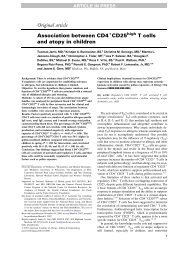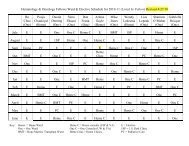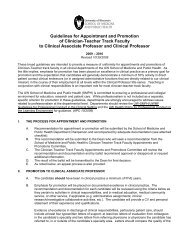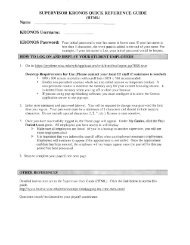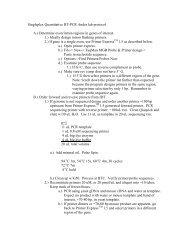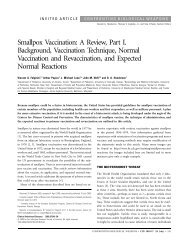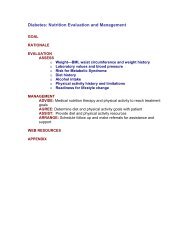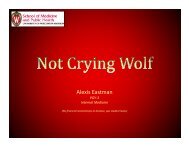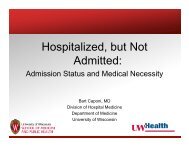VIRAL HEPATITIS HISTORICAL PERSPECTIVE
VIRAL HEPATITIS HISTORICAL PERSPECTIVE
VIRAL HEPATITIS HISTORICAL PERSPECTIVE
- No tags were found...
You also want an ePaper? Increase the reach of your titles
YUMPU automatically turns print PDFs into web optimized ePapers that Google loves.
<strong>HEPATITIS</strong> A VIRUS
<strong>HEPATITIS</strong> A - CLINICAL FEATURES•Jaundice by
EVENTS IN <strong>HEPATITIS</strong> A VIRUS INFECTIONClinical illnessInfectionALTResponseViremiaHAV in stoolIgMIgG0 1 2 3 4 5 6 7 8 9 10 11 12 13Week
CONCENTRATION OF <strong>HEPATITIS</strong> A VIRUSIN VARIOUS BODY FLUIDSFecesBody FluidsSerumSalivaUrine10 0 10 2 10 4 10 6 10 8 10 10Source: Viral Hepatitis and Liver Disease 1984;9-22J Infect Dis 1989;160:887-890Infectious Doses per mL
GLOBAL PATTERNS OF<strong>HEPATITIS</strong> A VIRUS TRANSMISSIONEndemicityDiseaseRatePeak Ageof InfectionTransmissionPatternsHighLow to highEarly childhoodPerson to person;outbreaks uncommonModerateHighLate childhood/young adultsPerson to person;food and waterborneoutbreaksLowVery lowLowVery lowYoung adultsAdultsPerson to person;food and waterborneoutbreaksTravelers; outbreaksuncommon
GEOGRAPHIC DISTRIBUTION OF<strong>HEPATITIS</strong> A VIRUS INFECTION
<strong>HEPATITIS</strong> A, UNITED STATES• Most disease occurs in the context of communitywideoutbreaks• Infection transmitted from person to person inhouseholds and extended family settings- facilitated by asymptomatic infection amongchildren• Some groups at increased risk– specific factor varies– do not account for majority of cases• No risk factor identified for 40%-50% of cases
ACUTE <strong>HEPATITIS</strong> A CASEDEFINITION FOR SURVEILLANCEClinical criteriaAn acute illness with:• discrete onset of symptoms (e.g. fatigue, abdominal pain, lossof appetite, intermittent nausea, vomiting), and• jaundice or elevated serum aminotransferase levelsLaboratory criteria• IgM antibody to hepatitis A virus (anti-HAV) positiveCase Classification• Confirmed. A case that meets the clinical case definition and islaboratory confirmed or a case that meets the clinical case definitionand occurs in a person who has an epidemiologic link with a personwho has laboratory-confirmed hepatitis A (i.e., household or sexualcontact with an infected person during the 15-50 days before the onsetof symptoms).
REPORTED CASES OF <strong>HEPATITIS</strong> A,UNITED STATES, 1952-2002454035Rate per 100,00030252015105052 56 60 64 68 72 76 80 84 88 92 96 2002YearSource: NNDSS, CDC
DISEASE BURDEN FROM<strong>HEPATITIS</strong> AUNITED STATES, 2001Number of acute clinicalcases reported10,609Estimated number of acuteclinical cases45,000Estimated number ofnew infections93,000Percent ever infected31.3%
INCIDENCE OF <strong>HEPATITIS</strong> A BY AGE GROUPIN STATES WHERE VACCINATION ISRECOMMENDED & CONSIDERED, 1990-2001502-18 Year Olds >18 Year OldsCases/100,000403020100200120001999199819971996199519941993199219911990Year
<strong>HEPATITIS</strong> A RATES,BY RACE/ETHNICITY; 1994Rate (per 100,000)130120121.21103020.72010.3104.65.56.40TotalAsiannon-HispanicBlacknon-HispanicWhiteRace/EthnicityHispanicNative American/Alaska Native
NUMBER OF YEARS REPORTED INCIDENCE OF<strong>HEPATITIS</strong> A EXCEEDED 10 CASES PER 100,000,BY COUNTY, 1987-19970-1 2-3 4-5 6-7 8-11
<strong>HEPATITIS</strong> A VIRUS TRANSMISSION• Close personal contact(e.g., household contact, sexcontact, child day-care centers)• Contaminated food, water(e.g., infected food handlers)• Blood exposure (rare)(e.g., injection drug use, rarely bytransfusion)
RISK FACTORS ASSOCIATED WITHREPORTED <strong>HEPATITIS</strong> A,1990-2000, UNITED STATESUnknown46%Sexual orHouseholdContact 14%Internationaltravel 5%Men who havesex with men10%Injection drug use6%Other Contact8%Source: NNDSS/VHSPContact of daycarechild/employee6%Food- orwaterborneoutbreak 4%Child/employee inday-care 2%
PREVENTING <strong>HEPATITIS</strong> A• Hygiene (e.g., hand washing)• Sanitation (e.g., clean water sources)• Hepatitis A vaccine (pre-exposure)• Immune globulin (pre- and postexposure)
PREPARATION OF INACTIVATED<strong>HEPATITIS</strong> A VACCINES• Cell culture adapted virus grown in humanfibroblasts• Purified product inactivated with formalin• Adsorbed to aluminum hydroxide adjuvant
<strong>HEPATITIS</strong> A VACCINES• Highly immunogenic• 97%-100% of children, adolescents, and adultshave protective levels of antibody within 1month of receiving first dose; essentially100% have protective levels after second dose• Highly efficacious• In published studies, 94%-100% of childrenprotected against clinical hepatitis A afterequivalent of one dose
<strong>HEPATITIS</strong> A VACCINE EFFICACY STUDIESVaccineSite/Age GroupNVaccine Efficacy(95 % Cl)®∗HAVRIX(GSK)2 doses360 EL.U.Thailand1-16 yrs38,157 94%(79%-99%)VAQTA ® ∗ ∗(Merck)1 dose25 unitsNew York2-16 yrs1,037 100%(85%-100%)JAMA 1994;271:1363-4; N Engl J Med 1992;327:453-7
<strong>HEPATITIS</strong> A VACCINESRecommended Dosages of Hepatitis A VaccinesAge Volume 2-DoseScheduleVaccine (yrs) Dose (mL) (mos)HAVRIX ® # 2-18 720 (EL.U.*) 0.5 0, 6-12>18 1,440 1.0 0, 6-12VAQTA ® ## 2-18 25 (U**) 0.5 0, 6-18>18 50 1.0 0, 6-12* EL.U. – Enzyme-linked immunosorbent assay (ELISA) units** Units# has 2-phenoxyethanol as a preservative## has no preservative
SAFETY OF <strong>HEPATITIS</strong> A VACCINE• Most common side effects− Soreness/tenderness at injection site -50%− Headache - 15%− Malaise - 7%• No severe adverse reactions attributed to vaccine• Safety in pregnancy not determined – risk likelylow• Contraindications - severe adverse reaction toprevious dose or allergy to a vaccine component• No special precautions forimmunocompromised persons
DURATION OF PROTECTION AFTER<strong>HEPATITIS</strong> A VACCINATION• Persistence of antibody• At least 5-8 years among adults and children• Efficacy No cases in vaccinated children at 5-6 years offollow-up• Mathematical models of antibody decline suggestprotective antibody levels persist for at least 20years• Other mechanisms, such as cellular memory, maycontribute
FACTORS ASSOCIATED WITHDECREASED IMMUNOGENICITYTO <strong>HEPATITIS</strong> A VACCINE• Decreased antibody concentration:− Concurrent administration of IG− Presence of passively-transferred maternal antibody− Age− Chronic liver disease• Decreased seroconversion rate:− HIV infection− May be related to degree ofimmunosuppression− Liver transplantation
USE OF <strong>HEPATITIS</strong> A VACCINEFOR INFANTS• Safe and immunogenic for infants without maternalantibody• Presence of passively-acquired maternal antibody bluntsimmune response• all respond, but with lower final antibodyconcentrations• Age by which maternal antibody disappears is unclear• still present in some infants at one year• probably gone in vast majority by 15 months
COMBINED <strong>HEPATITIS</strong> A<strong>HEPATITIS</strong> B VACCINE• Approved by the FDA in United States for persons >18years old• Contains 720 EL.U. hepatitis A antigen and20 µg. HBsAg• Vaccination schedule: 0,1,6 months• Immunogenicity similar to single-antigen vaccinesgiven separately• Can be used in persons > 18 years old who needvaccination against both hepatitis A and B• Formulation for children available in many othercountries
PRE-VACCINATION TESTING• Considerations: cost of vaccine cost of serologic testing (including visit) prevalence of infection impact on compliance with vaccination• Likely to be cost-effective for: persons born in high endemic areas Older U.S. born adults Older adolescents and young adults in certain groups(e.g., Native Americans, Alaska Natives, Hispanics, IDUs)
POST-VACCINATION TESTINGNot recommended:• High response rate among vaccinees• Commercially available assay not sensitiveenough to detect lower (protective) levels ofvaccine-induced antibody
<strong>HEPATITIS</strong> A PREVENTION• Pre-exposureIMMUNE GLOBULIN travelers to intermediate and highHAV-endemic regions• Post-exposure (within 14 days)Routine household and other intimate contactsSelected situations institutions (e.g., day-care centers) common source exposure (e.g.,food prepared by infected food handler)
ACIP RECOMMENDATIONS FOR PREVENTION OF<strong>HEPATITIS</strong> A USING <strong>HEPATITIS</strong> A VACCINE
<strong>HEPATITIS</strong> A VACCINATIONRECOMMENDATIONS:GUIDING PRINCIPLES• Need comprehensive strategy to reduceoverall rates Routine vaccination of children likely to bemost effective• Need creative approaches Formulation not available that would allowintegration into infant schedule
INCREMENTAL IMPLEMENTATION OFROUTINE <strong>HEPATITIS</strong> A VACCINATIONOF CHILDREN• 1996 - Children living in communities with thehighest rates• 1999- Children living in states/communitieswith consistently elevated rates during“baseline period”• All children nationwide
Number of CasesReported Hepatitis A Cases, By YearNorthern Plains Indian Reservation †500450400350300250200150100500South Dakota, 1968-20021968 1972 1976 1980 1984 1988 1992 1996 2000YearVaccinationprogram**** Estimated first dose coverage (children 2-12 years) = 71%** 2002 Preliminary data† Counties: Bennett, Corson, Dewey, Jackson, Roberts, Shannon, Todd, Ziebach* † Source: South Dakota Department of Health
<strong>HEPATITIS</strong> A INCIDENCEUNITED STATES ANDNATIVE AMERICANS 1990-200112010080Native AmericanVaccine LicensedACIP RecommendationRate604020United States01990 1992 1994 1996 1998 2000YearSource: NNDSS, CDC
1999 RECOMMENDATIONS FOR<strong>HEPATITIS</strong> A VACCINATION OFCHILDREN STRATEGY• Further incremental step• Not the same everywhere in the country Regional recommendations using ratebasedcriteria during a “baseline period”• Flexible implementation strategies Children or adolescents One or more single age cohorts Selected settings, e.g., day-care
INCIDENCE OF <strong>HEPATITIS</strong> A BY REGION,UNITED STATES, 1966-1997Low Mod. Elevated Consistently ElevatedCases/100,0006050403020100Baseline 1987-9719961993199019871984198119781975197219691966Year
1999 ACIP RECOMMENDATIONS FOR ROUTINE<strong>HEPATITIS</strong> A VACCINATION OF CHILDRENChildren Who Should be Routinely Vaccinated- living in states, counties, and communitieswhere the average hepatitis A rate was ≥ 20cases/100,000 during baseline period.Children Who Should be Considered forRoutine Vaccination- living in states, counties, and communitieswhere the average hepatitis A rate was
1999 ACIP RECOMMENDATIONS FORSTATEWIDE ROUTINE <strong>HEPATITIS</strong> AVACCINATION OF CHILDRENRate > 20/100,000*RecommendedRate 10-20/100,000*ConsideredRate < 10/100,000*Not statewide* Based on average incidence rate during baseline period (1987- 97)
Hepatitis A Incidence, United States,1980-2002*Cases/100,0001612841995 vaccine licensure1996 ACIP recommendations1999 ACIP recommendations2002 rate* = 2.90*2002 rate provisional1980 '85 1990 '95 2000Year
Incidence of Hepatitis A by U.S. Region, 1990-2002*Cases/100,00030252015105RecommendedConsideredNo Statewide↓86%↓89%↓50%0'02'012000'99'98'97'961995'94'93'92'911990Year*2002 rate provisional
DOSES OF PEDIATRIC <strong>HEPATITIS</strong> A VACCINEPURCHASED BY PUBLIC SECTORBY U.S. REGION, 1995-2002Recommended Considered No StatewideDoses/1,000 Children1801601401201008060402001995 1996 1997 1998 1999 2000 2001 2002Year
Summary of Hepatitis A Incidence by Region:Baseline, 2001, and 2002Rate/100,000Baseline 2001 2002*Recommended25.94.53.6Considered16.13.81.8No statewide5.63.42.8% Baseline Cases % Cases 2001*2002 rate provisional
1987-97 average incidenceHepatitis AIncidenceNYCDC2002 incidencerate per 100,000 0-4 5-9 10-19>=20NYCRate per 100,000DC> = 2010 - 195 - 90 - 4rate per 100,000 0-4 5-9 10-19>=20
TOP 10 STATES WITH THEHIGHEST <strong>HEPATITIS</strong> A RATESTHEN1987-1997Avg. rateRateArizona48D.C.14Alaska45Georgia12Oregon40Arizona8New Mexico 40Rhode Island 7Utah33Connecticut7Washington 30Kansas7Oklahoma24Maryland6South Dakota 24Massachusetts 6Idaho21Texas6Nevada21Florida5California20California5NOW2001
<strong>HEPATITIS</strong> A RATE, BY AGE AND GENDERUNITED STATES, 1990Age
<strong>HEPATITIS</strong> A RATE, BY AGE AND GENDERUNITED STATES, 2001Age5-910-1415-1920-2425-2930-3435-3940-4445-4950-5455-5960+Female
<strong>HEPATITIS</strong> A INCIDENCE BY GENDER,UNITED STATES, 1990-2001Cases per 100,0001816141210864MaleFemaleRatio\21.81.61.41.210.80.60.4Male : Female Rate Ratio200.201990 1991 1992 1993 1994 1995 1996 1997 1998 1999 2000 2001Year
ACIP RECOMMENDATIONSPERSONS AT INCREASEDRISK OF INFECTION, 1996• Men who have sex with men• Illegal drug users• International travelers• Persons who have clotting factor disorders• Persons with chronic liver disease
STD Treatment GuidelinesMMWR May 10, 2002 51(RR06)“Vaccination against hepatitis is themost effective means of preventingsexual transmissionof hepatitis A and B.”
Integration of services for highriskadults• Reports of converging epidemics (STD, HIV,hepatitis) impacting MSM, IDU, and othersat risk• Integration of services that target MSM,IDU, and others at risk saves $$$ andimproves services
Lack of integrated preventionactivities leads to…•Individuals infected with HIV, hepatitis and otherSTDs remain undiagnosed, untreated and uninformed•Infected and uninformed have higher levels of riskybehavior and continue to transmit•Counseling is mistakenly based on limited diagnosisand individuals at risk for HAV and HBV don’t getimmunized
<strong>HEPATITIS</strong> A IN THE UNITEDSTATES -2002• National rate lowest yet recorded Continued monitoring needed to determine if low ratessustained and due to vaccination Evaluation of age-specific rates to assess impact ofvaccination strategy• Rates increasing in some states Occurring among adults in high risk groups (e.g. MSM,drug users)
<strong>HEPATITIS</strong> A VACCINATIONIN THE UNITED STATESCHALLENGES FOR THE FUTURE• Continue implementation of the currentrecommendations for vaccination of children Sustain vaccination in face of falling rates• Further reduce incidence Vaccination of high-risk adults Vaccination of children nationwide



